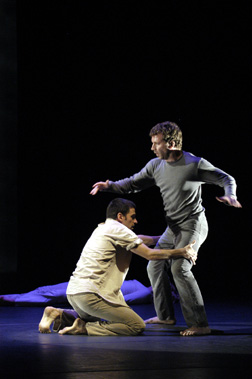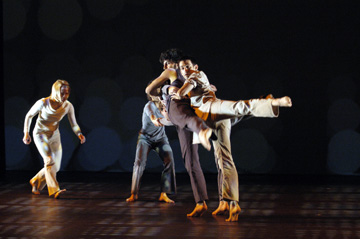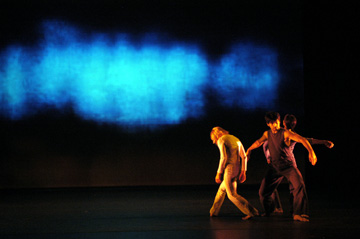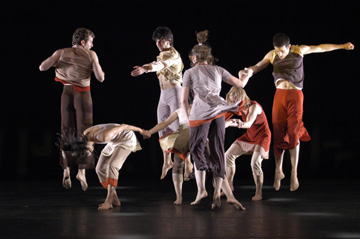A Disjointed Deconstruction
Doug
Varone and Dancers
Deconstructing English, Home, Castles
Clarice Smith Performing Arts Center
Ina and Jack Kay Theatre
Friday, October 29, 2004
By
Clare Croft
copyright
© 2004 by Clare
Croft

“Deconstructing English’s” slow pace and interrupted phrases made the piece the movement equivalent of a poem full of unwanted commas and semi-colons. The insertion of kinetic punctuation marks dissolved the emotional fluidity that usually propels Mr. Varone’s dances. His choreography does not work in the same manner as language, where punctuation marks and capitalization make meaning clearer. In “Deconstructing English,” Mr. Varone shows the audience that one dancer’s leg moved because another dancer’s hand hit the back of the first dancer’s knee. Seeing the nuts and bolts of the phrases diminished the dance’s power.
Mr. Varone has broken down his process on a variety of levels here. He manipulates his movement in a less connected way. He commissioned David Van Tieghem to transform Bach’s “English Suites.” And, through ten weeks of blog entries on the Clarice Smith website, he chronicled his rehearsal and development process. (I chose to skim two entries of the blog, only after seeing the work. Like reading the world’s longest program note, I felt like reading the ins and outs of the process would color my viewing of the actual piece in its final form. However, I applaud the Smith Center and Varone’s attempt to demystify the dance-making process for audiences.)

The size of the projections countered the overall progression of the movement as well, particularly in “Deconstructing English’s” first half. The dancers began moving, using their bodies’ full lengths, particularly Natalie Desch who repeated a skipping chug with a long curve of the back, leg extended in an arabesque so lovely, long, and in a way, classical, that she rivaled any Shade’s entrance in “La Bayadere.” As the piece progressed, the movement grew tighter and tinier, dancers drawing more closely together. The smallness climaxed in a solo for Daniel Charon, where he tinkled his way about the stage in a tap dance.
Past Mr. Charon’s solo, I grew confused about the work’s overall trajectory. Two men engaged in a laughing conversation, moving their mouths and gesturing wildly. Stephanie Liapis began her solo by laughing out loud and John Beasant III continually threw himself on the ground, sliding on his stomach. Well danced and sometimes interesting, the work just never found continuity.

"Home" feels like a glimpse inside a couples’ shared soul, a trait shared by “Castles’” duets Mr. Varone’s work helps me settle a quandary I’ve often pondered about the causal relationship between movement and emotion in dance. It seems unrealistic for a dancer to move because of an emotion: “I am happy, therefore I will sauté.” In duets for Mr. Beasant and Mr. Charon, then Ms. Desch and Kayvon Pourazar, the dancers do not move because of their feelings, but their movements are their feelings. Mr. Varone’s choreography makes the interior exterior. In a dance of new love, Ms. Desch crawls through Mr. Pourazar’s bent legs and outstretched arms, symbolizing the invasion of one person into another’s space and body, but most importantly his heart. The invasion is not unsolicited; Mr. Pourazar opens himself and allows Ms. Desch to softly place her head on his chest at duet’s end.
Mr. Beasant and Mr. Charon’s duet plays most effectively with “Castles’” reference to fairy tales, made most obviously by the work’s musical accompaniment, sections of Prokofiev’s “Waltz Suite, Opus 110,” known to dance audiences as “Cinderella.” In “Castles’” group sections, as in fairy tales, men and women couple. Mr. Varone references the formality of these couples in short moments: one man unfolds his arm regally to a woman, who performs the modern dance version of a courtly curtsy, her legs bend and her torso scoops underneath the man’s hand.

Compared to “Castles’” New York premiere last spring, Mr. Varone has retooled the work’s physicality and comedic effects, both of which help give the work a greater dynamic range. Mr. Charon and Mr. Beasant’s chest slapping was just one of several moments where the sound of body hitting body echoed through the theater. And, both in the men’s duet and in a group section featuring Ms. Fang, comedic moments have been freely sprinkled throughout. Ms. Fang continually tries to escape from the dancing group around her, once crawling on hands and knees out of a circle of swinging arms and looping legs.
Photos: (all
by Scott Suchman)
First: John Beasant, III and Daniel Charon in Doug Varone's "Deconstructing
English"
Second: From L to R: Natalie Desch, Kayvon Pourazar, and Stephanie
Liapis in "Deconstructing English"
Third:
Natalie Desch, Kayvon Pourazar, and Stephanie Liapis in "Deconstructing
English"
Fourth: (From L to R) Daniel Charon, Adrian Fang, Kayvon Pourazar,
Stephanie Liapis, Catherine Miller, Natalie Desch, and John Beasant, III
of Doug Varone and Dancers perform in "Castles".
www.danceviewtimes.com
Volume 2, No. 41
October 25, 2004
Copyright
©2004 by Clare Croft
|
|
|